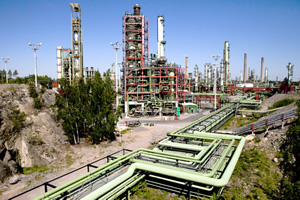Attention all passengers: this plane is flying on abattoir waste
on
Attention all passengers: this plane is flying on abattoir waste
Test flights recently carried out by Lufthansa and Finnair on passenger flights in Europe show that conventional kerosene can be replaced by biofuel without any technical problems. There are also sufficient feedstocks available to produce large amounts of "aviation biofuel" in the future. The main obstacle currently holding back the growth of the market are lack of demand and high price. Still, the world's number one producer of aviation biofuels, Neste Oil from Finland, is confident that the market will start to grow now that airlines will be included in the EU's Emission Trading Scheme from 2012 onwards.
 |
| Lufthansa flies an Airbus A321 using 50% renewable fuel in the tank of one of the aircraft’s two engines |
Neste Oil’s bio-kerosene is called NExBTL, which stands for Next Generation Biomass-to-Liquid. It is “next” or “second generation” because it is largely (though not entirely) made from non-foodstuffs, namely a mixture of plant oils (jatropha and camelina) and animal fats (abattoir waste). So-called “first generation” biofuels are controversial because they are made from foodstuffs and therefore compete with food supplies. Second-generation biofuels are also of higher quality and made by more advanced methods. SkyNRG also has a second-generation product: it is made exclusively from cooking oil recycled from restaurants. Both products have the advantage that engines do not have to be modified to use them.
Years ahead
Neste Oil, half-owned by the Finnish state, was founded in 1948 to secure Finland’s oil supply. In 2005 it started in its current form when it was split off from Fortum, the Finnish utility company which is also half-owned by the state. The company, which posted a turnover of €11.9 billion and operating profits of €323 million in 2010, has always focused on developing environmentally friendly products. Its corporate strategy is based on three pillars: supplying premium-quality products for cleaner traffic, expanding its feedstock base and leveraging its refining expertise. Neste’s key markets are northern Europe and the Baltic, as well as North America for NExBTL.
Lars Peter Lindfors, Neste’s Senior Vice President of Technology and Strategy, is confident about his company’s position in the biofuels market. ‘When it comes to renewable fuel we are years ahead of the competition’, he says. The first NExBTL refinery was brought online in 2007 at Neste’s main production facility in Porvoo, some 40 kilometres east of Helsinki. In 2009, capacity was doubled to 380,000 tonnes
| 'When it comes to renewable fuel we are years ahead of the competition' |
The key to Neste Oil’s success, in the company’s own view, is its technological capability. The processes the Finns use, however, remains largely a secret. As a spokeswoman puts it: ‘We have registered a lot of patents and nothing has been put out to licence.’
What is known about NexBtL is that, following a pre-treatment process, plant oils and animal fats are hydrogenated with phosphoric acid and caustic soda at a pressure of up to 80 bar; in other words catalysts are added and combined with hydrogen. What is crucial is that the end product has the same chemical formula as fossil-based diesel fuel, namely CnH2n+2, and can therefore be used in any type of diesel and jet engine without any modifications being required. This represents a considerable advantage over first-generation biodiesel, which mainly consists of fatty acid methyl esters (FAME). First-generation biodiesel can only be used to replace up to 7% of conventional diesel without engine modifications. Moreover, it leads to higher nitrogen oxide emissions, has limited storage possibilities, is hampered by problems with engine cleanliness and is less energy efficient.
An engine running on NExBTL, on the other hand, can even improve its performance, is resistant to cold (tested up to minus 40 degrees) and has a high combustion quality (a cetane number of 94). For diesel
| 'We have registered a lot of patents and nothing has been put out to licence' |
Official approval
Before the first Airbuses running (partly) on BTL kerosene could be put into regular passenger service, Lufthansa and Finnair needed an important document: official approval of the fuel for aviation purposes. This was granted on 1 July of this year by the American Society of Testing and Materials (ASTM). Lufthansa puts the cost of the entire six-month trial at €6.6 million, with the German government pitching in €2.5 million. Finnair, which did not get public funding, says cost was not a particularly significant factor in its four-flight test.
More important is that the team at Lufthansa are satisfied with what they have learned so far. Spokesman Peter Schneckenleitner tells EER: ‘So far we are very satisfied with the test flights. We have been flying now for a good two months and haven’t had any problems so far in terms of flight operations. But a detailed analysis has yet to be made.’ The entire supply of bio-kerosene needed was brought to Hamburg from Finland in one shipment. The airport of Hamburg is used because there refueler trucks are still used to fill up airplanes; airports like Frankfurt and Munich have only an underground hydrant pipeline system, where there is a risk of fuels getting mixed.
Finnair is apparently also satisfied with the results of its test. The company did not want to say why it did not choose Neste Oil as it supplier. ‘For Finnair, SkyNRG’s product is the best option available at the moment in terms of ecological and social sustainability’, is all a spokesman of Finnair wanted to say. At Neste Oil, Juha Lehtonen, Vice President Research & Technology, is content to note: ‘We talked to them but we are talking to several other airlines too.’
In fact, Lindfors emphasizes that he ‘would welcome more competitors’, because that would help bring the price down and would also help bio-kerosene producers gain more political clout. The price of NExBTL is currently double that of conventional kerosene. A key reason for this is the lack of production plants. ‘Compared to road traffic, there are not sufficient incentives to use renewable fuels in aviation’, Lindfors says. ‘The price of renewable aviation fuel is driven by the prices of road traffic biofuels. Conventional jet fuel price, on the other hand, is being driven by crude oil price.’
Neste Oil regards the biofuels market in the aviation sector as an emerging market in which the volumes will initially be fairly small. ‘In the future, however, we expect demand to grow significantly’, says Lindfors. ‘Airlines are becoming increasingly interested in the potential of these fuels, as the
| 'The price of renewable aviation fuel is driven by the prices of road traffic biofuels. Conventional jet fuel price, on the other hand, is being driven by crude oil price' |
Bottle upon bottle
Meanwhile, the researchers in Porvoo are not standing still. They are working hard to find new and better feedstock for their biodiesel. At the moment, the Finns are producing renewable diesel from 46% crude palm oil, 7% palm fatty acid distillate (PFAD), 28% stearin, 17% waste animal fat (Neste buys up Finland’s entire production of abattoir waste while abattoirs in Australia and New Zealand supply the refinery in Singapore) and 2% other (e.g. rapeseed oil). Palm oil is a controversial product. It can originate from land cleared of rain forest or can be taken from the food chain, and the Finns have been criticised for procuring theirs from uncertified sources. At the company’s headquarters in Espoo these accusations are firmly denied. Rather than buying crude palm oil, ‘the company’s main focus is on sidestreams and waste products produced during palm oil production, such as stearin and palm fatty acid distillate’, a spokesman says. The company has given assurances that they will buy only certified palm oil by the end of 2015.
In Juha Lehtonen’s lab, however, the shelves are lined up with bottle upon bottle and container upon container of organisms and substances, which will hopefully one day lead to the discovery and development of new feedstock. Soon by-products of oil plants and fish oil will complement and replace
|
|
| Neste Oil refinery for biofuels in Porvoo (Helsinki Times) |
The next item on the lab’s agenda will be microalgae oil. Neste Oil is working together with Dutch and Australian universities and research institutes on long-term projects in this respect. The potential would be huge, but Juha Lehtonen is reluctant to give a likely timeframe for their development.
Similarly impressive are the prospects for another feedstock: biowax. The Fischer-Tropsch process for turning wood waste into gas has been known for decades, but no-one has yet been able to make it commercially viable. The German company Choren Industries and the American company Range Fuel have both failed to do so. Neste Oil is now running a test plant together with Stora Enso, the Swedish-Finnish forestry corporation. Plans are under way for a commercial plant, but both sides are somewhat reluctant due to the costs involved. Without assistance from the EU '- a funding application has been submitted to Brussels with a decision expected later this year. The idea behind the plant is dry and gasify forest residues, and to refine the remaining product (the biowax) into biodiesel.
Neste calls this "third-generation" biofuels, though of course it is still standing with one leg in the first generation. The company's goal is to exit the food chain altogether by 2020.
Meanwhile, at the end of the day, Juha Lehtonen drives to his local Neste service station and fills up with 100% NExBTL at a price of €1.519 per litre. He’s also part of the test fleet.
|
Aviation biofuels taking off The market for aviation fuels is quickly taking off in Europe at this moment. A number of suppliers are active in the market and various airlines are flying partially with biofuels. One very active player is Dutch producer SkyNRG, founded in 2009 by Air France KLM, Dutch oil company North Sea Group and consultancy Spring Associates. SkyNRG has supplied Finnair for four test flights and has signed up Thomson Airways as its second customer. Last week, KLM also started flying on SkyNRG's unique product, which is fully based on cooking oil recyled from restaurants. SkyNRG's Managing Director Dirk Kronemeijer says that Finnair is very satisfied so far with the test results. The advantage of SkyNRG's product, he says, is that it is fully disconnected from the food chain. 'We cooperate with a number of NGO's, including WWF, that tell us what is and what is not allowed. In this way our customers can be sure they use fully sustainable biofuels.' The disadvantage of using discarded cooking oils, says Kronemeijer, is that the amount that can be produced is obviously limited. But Kronemeijer believes that this problem will be solved in future. 'There is a lot going on at the moment and we are convinced that many more feedstock optiions will become available.' Meanwhile, in Spain aviation biofuels have also taken off. News agency UPI reported this week that Iberia flew an Airbus A320 from Madrid to Barcelona using a mixture of conventional jet fuel and biofuel made from a species of camelina. The biofuel was supplied by Spanish energy producer Repsol. It was the first commercial flight in the country powered by biofuel. |



Discussion (0 comments)